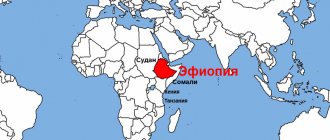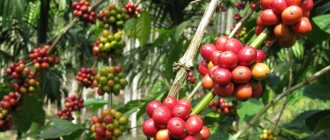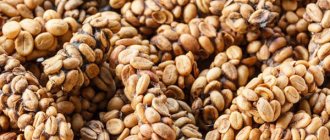In order for a coffee tree to grow and begin to bear fruit, you need to spend a lot of time and effort. In order to obtain a high-quality product, most of the steps are performed manually. In addition, attention is paid to the location of the plantations. Naturally, true connoisseurs of the aromatic drink want to know how coffee grows and in which countries the plant is grown.
Where and how is coffee grown in the world?
Where coffee is grown is a question that has an answer. Subtropical and tropical zones are the leaders in planting and growing evergreen coffee trees. Favorable climatic conditions: high temperature, humidity, and high altitudes allow coffee to be grown on a plantation scale.
This matter has its own characteristics. Seedlings must grow throughout their life at an elevation and germinate in soil of volcanic origin. They constantly need to be in the shade of large trees with voluminous foliage to protect them from direct sunlight. It is also advisable to maintain a stable temperature of the environment, otherwise the fruits will be spoiled. If the temperature changes, the plant may even die.
After planting in the soil, by the age of three years, coffee begins to bloom. Small white flowers appear on it, after which the fruits begin to develop. Visually, the fruits are similar to a large red-burgundy berry. Inside this berry are grains. The fruits ripen in less than a year: from eight to eleven months, depending on the variety.
Coffee tree at home
To grow a coffee tree from seeds at home, you need to keep them in potassium permanganate for disinfection and place them on top of previously prepared soil consisting of sand and leaf humus. The seeds are not sprinkled, but covered with glass or polyethylene on top, with regular ventilation. The air temperature in the room should not drop; 20 degrees is considered optimal. The soil should always be moist.
Young coffee sprouts
If these conditions are met, the seeds can germinate in 2 months. The sprouts have a very weak root system, so any transplantation before the appearance of several pairs of leaves is contraindicated. The ideal place for a pot with a young plant is near a south window, where there is a lot of warmth and light. The scorching rays of the sun are prohibited, as they can burn young leaves.
Watering is required abundantly, as well as spraying, to maintain high humidity. If you properly care for the plant, it will produce flowers and berries, which, once fully ripe, can be used to make a drink. The plant is protected from drafts, replanted as the root system grows, and regularly sprayed with fungicides to prevent disease.
The tree requires artificial pollination, pruning as it develops strong branching and fertilizing every 10 days in the summer. Caring for the plant is generally not difficult, but it requires a large free space and the ability to form a bush through proper pruning.
Where is coffee produced?
Four regions are considered coffee magnates: Central America and South America, Asia and the birthplace of aromatic beans - Africa.
Central American region:
- Honduras harvests 6 million bags of coffee per year. Of these, only 10% remain within the country. Until the discovery of our own varieties, high-mountain Honduran coffee was used as a blending product.
- Mexico is located between mountain ranges and, despite this, it is the least prominent representative of the coffee countries. It supplies 4 million bags a year, most of which goes to the United States.
- Guatemala is one of the TOP 10 largest producers of coffee beans: it manages to grow 3-3.5 million bags per year. As with Mexico, half of the harvest is sent to the United States.
South American region:
- Brazil is the country of coffee. The southern states of Brazil are home to high-mountain plantations that supply almost a third of all coffee on the planet to the world market. Every year, 36 million bags, each weighing 60 kilograms, are collected throughout the country.
- Colombia is the 2nd largest coffee producer, producing 10 million bags each year. The sophistication of Colombian varieties is determined by the hot southern climate of the country, in which the best coffee can grow: Columbia Bogota and Colombia Medellin Supremo.
- Peru differs from previous countries in that it places emphasis on industrial development. In agriculture, Peru lags noticeably behind its larger sister neighbors - they supply a total of 5 million bags of coffee per year.
Asian region:
- Vietnam is located in Southeast Asia. The climate and highlands, comfortable for heat-loving plants, allowed this Asian country to produce 18% of all coffee beans in the world.
- Indonesia ranks fourth among coffee bean producing countries. Southern location, continuous mountain ranges, humid climate - all this is the key to successful agriculture in the country.
- India is famous for its plantations. It has extensive exports to America and Europe, from where at least 1/3 of the total harvest goes to Italy for the production of coffee blends. India was also the first country to begin aging grains under the monsoon ocean winds.
African region:
- Ethiopia supplies coffee to 53 countries. Coffee exports are the main source of the Ethiopian economy, accounting for 60% of total exports. Almost 90% of the total population works in agriculture, and the size of plantations exceeds 500 thousand hectares.
- Uganda grows coffee trees as well as sugar cane. 4 million bags of grain leave the country annually, thereby forming the basis of exports.
- Cote d'Ivoire is located in western Africa. This country, like most African countries, is characterized by an orientation toward agriculture. Côte d'Ivoire ranks first in the world in cocoa production and third in coffee cultivation.
Regions where coffee trees grow
Most of Africa, with the exception of the very north and south, is suitable for trees. Ethiopia, Cote d'Ivoire, Uganda, Kenya and Tanzania are famous for their product. South and Southeast Asia grow grains primarily for domestic consumption, with the exception of a few countries. The region is famous for its high quality robusta.
The economies of Central America and large parts of South America are developing largely due to the demand for goods. The main export leaders are concentrated here.
Special varieties have been bred for growing heat-loving trees in Australia, but it is too early to talk about mass production of the Australian product.
Where does Arabica and Robusta grow?
Arabica (Coffee Arabica) is grown throughout the coffee belt. In Brazil these are the varieties Maragogipe and Santos. Maragogype is known for its large grains and smooth chocolate flavor. Santos - a sourish-nutty piquancy that can be complemented with cream. The delicate Medelline and fruity Andino grow in Colombia.
Peru has distinguished itself with its delicious Yanesha variety, which has a mild hazelnut and caramel flavor.
Honduras supplies San Markos with a distinct chocolate and walnut flavor. Mexican Chiapas tastes of dried fruits with light chocolate notes, while Todos Santos from Guatemala has a rich plum flavor. It's best to drink it with chocolate.
Historically, Vietnam exports Coffea Canephora. Arabica is not popular in this country, so when choosing Vietnamese coffee you need to take into account that Robusta will be offered. Indonesia, on the contrary, produces high-quality Arabica coffee: Sumatra Gayo Highland is a caramel-tobacco coffee with a citrus flavor. Tart Indian Karnataka coffee has a spicy aroma and mild spice flavor.
The famous coffee varieties from Ethiopia, Yirgacheffe and Sidamo, are recognizable due to their winey aftertaste, which is characteristic of all Ethiopian beans. On the plantations of Uganda, 80% of the country's coffee is robusta with a flavor of tobacco and dark chocolate. This option is ideal for lovers of aromatic tart drinks. Western Côte d'Ivoire is a supplier of green bitter robusta, the country's most important agricultural export.
Rating of coffee producing companies
First of all, here we need to answer the question of how coffee is drunk in different countries. Some use Turkish, some use French press, some use instant sublimate to make beer with boiling water.
Coffee bean producers
The grain product is considered the most natural and is valued by true coffee lovers. Brands that guarantee quality are the following brands.
- it is famous for its exquisite quality and has been delighting its connoisseurs for several decades. This coffee has a pleasant aroma and a sour aftertaste.
- JULIUS MEINL. Product of Austrian origin. The coffee is roasted evenly and there is no bitterness in the drink after brewing. The rich taste is obtained through proper processing of the grains.
- To create this product, whole Arabica beans are used. The product has five degrees of roasting, so after steaming it acquires an unforgettable radiant taste.
Ground coffee producers
- The company offers high-quality processed coffee to the entire market. The final drink acquires fruity notes and a pleasant aftertaste of chocolate.
- LIVE COFFEE. The beans are fried according to a special recipe. The drink has the aroma of bourbon and chocolate.
- Makes coffee in Naples. The taste of the drink has sourness. Made from high quality Arabica beans.
Producers of ground coffee in the Russian Federation
Manufacturers of instant coffee
- Suitable for natural coffee connoisseurs who do not have free time for preparation. Roasting is carried out using a special alpine technology.
- PAPER NOIRE. 100% natural Arabica is used in the production of the product. Thanks to the sealed packaging, the aroma of coffee is preserved for a long time.
- Nescafe. Instant base for an invigorating drink. Manufactured in accordance with European quality.
Is coffee grown in Italy and Russia?
Packages of coffee beans may be marked “made in Italy” or “made in Russia.” Whether coffee grows in Italy and Russia is a topic that requires special attention.
The climatic conditions of European countries do not allow the cultivation of the whimsical coffee tree. That is, coffee does not grow in Russia either. Even the highlands of the country are not suitable for these purposes due to the unstable climate. Italy, like Russia, produces delicious drinks based on purchased grains. The Italians have especially excelled in the art of blending different varieties, which is why the most popular espresso and delicious, invigorating cappuccino have appeared in the world. In the Russian Federation, espresso as a preparation method enjoys incredible success in coffee shops of various levels.
Historical reference
The tonic and tonic properties of the fruits of the coffee plant were known to man as early as the ninth century. Then the berries were eaten raw, in their pure form or with the addition of animal fat and milk.
Over time, people learned to make an infusion from the peel and pulp of fruits. Coffee in its usual form from ground beans appeared in the 13th century.
How does a coffee tree grow?
The plant is grown on plantations located on high mountain slopes at an altitude of 1000 to 2500 m. The process itself consists of the following stages:
- The seeds are processed and then placed in containers for germination. After 10 weeks, shoots appear.
- When the seedlings reach 5 cm in height, they are transplanted into large containers and transferred to the greenhouse. Some farmers refuse greenhouses, believing that planting directly in open ground hardens and strengthens the plants. Shoots are planted on tall trees, protected from wind, rain and hot sun.
- A coffee plant can be stored in a greenhouse for 6-12 months. During this period, it grows to 30 cm or more, after which it moves to a permanent place - a well-lit, wind-protected place where the sun's rays will fall on the seedlings in the corner.
- The first flowering of a young plant begins in the third year of life. The flowers are white, similar to jasmine. The fruits do not always set during the first flowering; sometimes the berries may appear only after a year.
- The flowering period is very short, no more than 2 days. Then the petals fall and the fruits set. Outwardly, they look like cherries - the same color, shape and size.
- The coffee plant produces a full harvest at 5 years of age. Ripe clusters of purple or red berries.
- The ripening of fruits of some varieties lasts 8 months, others - up to 11. Coffee is harvested at different times of the year, depending on the place of cultivation: Brazil - from May to September, Central America - from October to March, Africa - from late October to April.
- The trees can grow up to 9m and are pruned to 3m to make harvesting easier.
- The maximum yield of a coffee plant is from 8 to 15 years of cultivation, after which its yield decreases, but it continues to bear fruit until it is fifty years old.
The berries consist of a peel, pulp and a capsule containing 2 grains. Sometimes there are berries with one seed.
Green coffee berries
1 coffee plant produces from 0.4 to 4 kg of beans, less often – 5 kg. Plants grown in equatorial climates are capable of producing up to three harvests per year.
Found a coffee cherry and two coffee beans
Coffee harvesting is carried out in two ways: manual or machine. The manual method is labor intensive, but the build quality is better. It allows you to pick only ripe fruits, since berries on the same plant do not ripen at the same time. To get 500 g of finished raw materials, you need to collect 2500 g of berries. The work continues every day until all the berries are ripe. Most of the world's coffee is harvested by hand.
Picked coffee cherries
The machine method is simpler - a special harvester drives through the coffee bushes and shakes off all the berries. Subsequently, manual sorting of fruits is necessary. Typically, the machine method is used in the plains and in countries where the coffee cherries ripen at approximately the same time.
Under what conditions does coffee grow?
High yields and high taste qualities of the product are obtained from plants grown under certain conditions.
The coffee plant grows best in:
- Soft, oxygenated soil, acidic environment. The plantations where coffee is grown are located on high mountain slopes with volcanic soil.
- Stable climate. Sudden temperature changes are detrimental to this plant, so the coffee plant is grown only in the equatorial zone.
- An environment with a certain level of humidity. The optimal precipitation rate is 3000 mm/year.
- High altitude location. The quality of the resulting raw materials depends on this parameter. The best are grown on plantations located at an altitude of 2000 m above sea level.
- Hot weather. Plants prefer a certain air temperature: 18–23 ° C is considered ideal, 13–27 ° C is considered acceptable. Heat accelerates the ripening of berries, which worsens the taste of beans.
- Abundant lighting. There is a nuance: the plant should not be exposed to direct sunlight, the lighting should be diffused. Therefore, plants are planted in areas shaded by taller trees with dense foliage.
The coffee plant is susceptible to diseases, the most dangerous of which is rust. This fungal disease destroys crops and can destroy plantations.
Optimal conditions
The birthplace of coffee plants is Ethiopia and the territory of modern Yemen, which is located on the Arabian Peninsula. Here these plants grew wild.
The following climatic conditions are necessary for tree growth and fruit ripening:
- average annual air temperature – 20 ° C;
- precipitation – 1000-1800 mm per year;
- some trees need greater height.
Interesting! What is coffee made of?
These conditions correspond to a tropical climate. In other climate zones, coffee plants are found as unsuitable ornamental plants. Whether coffee grows on mountain slopes or in valleys depends on its taste and smell.
Belt coverage area
Areas with climatic conditions for growing the coffee plant are located along the equator. They move away from it at 20° north and south latitude. A corridor limited by these latitudes surrounds the planet. Hence the name of the Earth's coffee belt.
According to the world map, the belt covers the territories of South and Central America, Central Africa, Southeast Asia, Australia, New Zealand and the islands of Oceania. In total, coffee is grown in 80 countries, but only 50 of them are global exporters.
The turnover of coffee raw materials is 5 million tons per year. There are leaders in this market: coffee-producing countries. Yield is measured in bales of 60 kg of green beans each.
Who brought coffee to Russia?
Some sources report that Peter I brought coffee to Russia and visited Holland in 1697, where he was pleasantly surprised by the unusual taste and aroma of this invigorating drink. Since 1718, coffee was served at all important dances and events, and already in 1740 the first cafe operating according to the traditions of Western countries was founded in St. Petersburg.
There are other hypotheses, since “The Tale of Past Years” talks about how Prince Vladimir Svyatoslavovich drank a thick drink. Moreover, the official date of the appearance of coffee in Russia is 1665. It is believed that the doctor prescribed Alexei Mikhailovich to drink a cup of the invigorating composition “for colds, headaches and arrogance.”
Does coffee grow in a country in the Southern Hemisphere?
Coffee beans can grow freely on the Australian continent, but only in the eastern and northern parts of the country, in regions such as the Atherton Tablelands and part of the state of Queensland. In other regions, trees will bear little fruit due to unsuitable growing conditions.
Coffee is one of the most interesting drinks from a gastronomic point of view. The variety of varieties, preparation options and distribution routes allows you to enjoy an amazing coffee drink created from African beans using Italian technology.
Travel along the coffee belt
If you take an imaginary journey along the coffee belt, then various pictures will appear before your eyes. These are mountains and plains, a humid and temperate climate, temperature changes (though in the positive zone). On the way you will meet Arabica and Robusta, Liberica and Excelsa trees. You will have the opportunity to communicate with people of all races: Caucasoid, Mongoloid and Negroid. And you will have to communicate in a variety of languages: Spanish, Portuguese, Indonesian, Hindi, Vietnamese, Ahmar, Swahili, French. And everywhere you will be offered their unique piece of the coffee belt.
Everywhere you will see how difficult it is to care for coffee plantations and manually harvest the next crop. Despite the natural landscape and climatic diversity, despite the differences in languages, faith, and way of life, people work on coffee farms everywhere for whom coffee is the basis of their way of life and world order. Often unfair and complex. That is life. Even in such an exotic corner of our planet as the coffee belt.
The figure schematically shows the habitat of coffee - Arabica and Robusta. This is a fairly limited space on Earth and in the temperature zone. The range of altitudes above sea level - from 200 m to 2 km - is comparable to the range of latitudes (coffee belt zone). The acceptable temperature range for normal ripening of coffee berries is from 15 to 25 degrees Celsius. The graph shows that for Robusta the growth conditions are less finicky than for Arabica.
It is easy to notice that Arabica does not overlap with Robusta. A border of about 300 meters wide separates the habitats of these plants. This also shows why Arabica is a more expensive variety of coffee bean. The fact is that this type of tree grows in the mountains or on hills. Therefore, one of the reasons for the higher price of Arabica than Robusta is the complexity of transporting finished coffee beans down to civilization.
The best coffee
Let's not beat around the bush: Geisha coffee is the best. Approximately 18% of samples of this variety scored 96-100 points on the Q-Grade scale. This variety outperforms other coffee tree varieties in all respects, having more specimens at the top of the list than at the bottom.
A couple of interesting finds:
- The Pacamara variety is sometimes compared to Geisha, but according to statistics, only 2.22% of samples of this variety managed to score the highest score. Kenyan coffees SL28 and SL34 performed much better, while Bourbon also fell flat at 2.38%.
- It is worth noting that the Typica variety has more quality problems compared to other varieties. Almost every fifth sample of the Typica variety scored less than 89 points. This is a poor result, even compared to the more common specialty coffees: Caturra, Catuai and Bourbon.
- I would like to pay more attention to the varieties of coffee trees - Ethiopian heritage. Although Ethiopian beans are commonly referred to as “heirloom” beans, scientists do not consider Ethiopia to be the sole origin of coffee.
What is better ground or instant coffee?
Natural ground coffee is safer for health, since it does not contain chemical components that are added to the instant drink, and it has less effect on the acidity of the stomach. But it also contains more caffeine.
Interesting materials:
How to wash faux fur items? How to wash faux leather products? How to wash cotton products? How to wash goat down products? How to wash leather goods? How to wash linen products? How to wash wet silk items? How to wash nylon products? How to wash products made from mink fluff? How to wash corduroy items?











